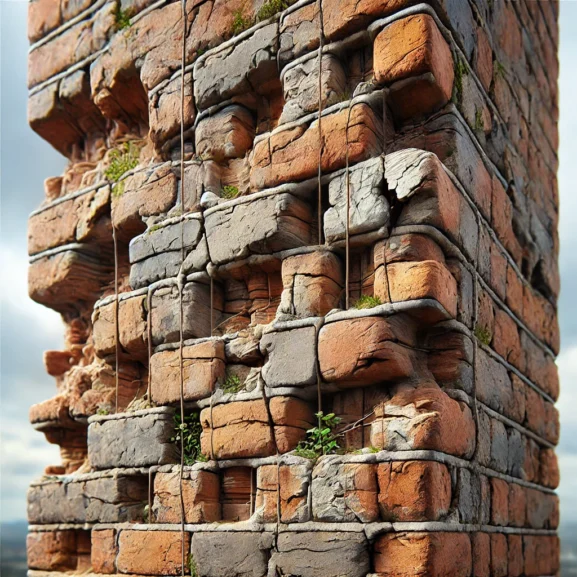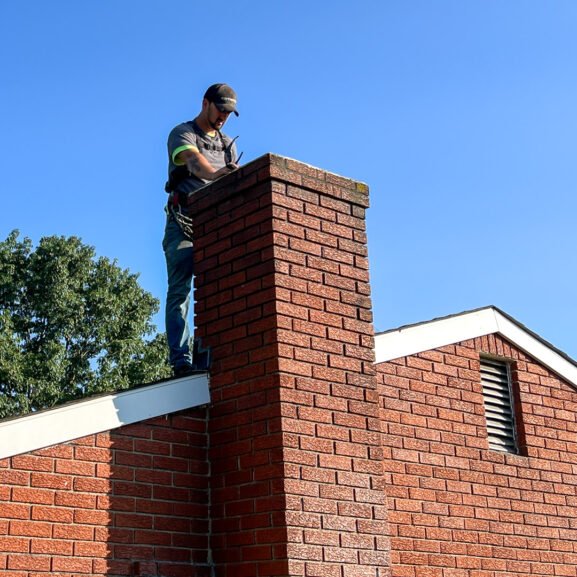Prevent Hazards: Manage Overhanging Trees Dropping Debris into Chimneys
Overhanging trees can make our homes look beautiful, but they can also cause problems. One common issue is debris falling into chimneys. Leaves, twigs, and other materials can build up. This can block the chimney and affect its performance. It can also create safety risks.
In this article, we’ll look at how to spot and deal with debris in chimneys caused by overhanging trees. We’ll also share tips on how to prevent these problems. By understanding these issues, we can keep our chimneys safe and working well. This way, we can enjoy our cozy fires without any worries.
Chimney Care 101: Dealing with Overhanging Trees and Falling Debris
Debris from overhanging trees causes chimney problems. Leaves, twigs, and tree branches can create blockages. These blockages disrupt airflow and pose chimney hazards like fires. Our solution to this leafy mystery? Regular chimney cleaning and tree maintenance.
We’re here to keep your chimney clear. Here are some essentials:
- Chimney Obstruction: Falling leaves and twigs block the flue. This can lead to dangerous chimney fire risks. Schedule regular cleaning to prevent issues.
- Tree Maintenance: Regular tree trimming stops debris. Prune those pesky branches to ensure they stay away from your chimney. No one wants a twig surprise in the fireplace.
- Debris Blockage: Check your chimney for obstructions often. If you suspect blockage, call us. We don’t recommend DIYs—it’s safer with a pro.
Regular care helps avoid serious chimney problems. Feel like your chimney’s hiding secrets? Reach out to professionals for consultation.
For further guidance, look into these resources on chimney fire safety from NFPA and tree trimming tips. Stay safe, warm, and thoroughly entertained by your twig-free fireplace adventures.
Causes of Debris Accumulation
Overhanging trees contribute significantly to debris accumulation in chimneys. Understanding the causes helps in formulating effective solutions and maintaining chimney safety. Let’s explore the types of trees involved and how seasons affect debris.
Types of Trees Commonly Involved
Certain trees have a reputation for creating chimney debris nightmares. Oak, maple, and pine trees are the usual suspects. Their branches drop leaves and sometimes even twigs into chimneys. Oaks drop their acorns. Maples spread their helicopter seeds like confetti. Pine trees add to chimney problems with their needle showers. These fallen parts can block your chimney. This makes chimney cleaning even more important. To keep your trees in check, trim them regularly. Reach out to professionals for consultation.
Seasonal Impact on Debris
Seasons play a key role in chimney debris accumulation. In autumn, leaves fall and create piles. These piles can block the airflow in your chimney. Winter winds break off tree branches. These branches can also block your chimney. In spring, fresh twigs and leaves can cause problems too. Stay alert during these seasons to reduce chimney hazards. Don’t let the next twig invasion catch you off guard. For fire safety resources, check out NFPA or CSIA.
Impact on Chimney Functionality
Overhanging trees often shed debris like leaves, twigs, and branches into chimneys. This can be a problem, but don’t worry. We’re here to help! We can keep your fireplace clean and cozy. Reach out to professionals for consultation.
Blocked Ventilation
Chimney debris, like twigs and leaves, can block your chimney. This is a big problem for homeowners. When debris builds up, airflow is restricted. This affects how well your chimney works. Here’s what happens:
Reduced Draft: Smoke can’t exit properly. This turns your cozy living room into a smoky sauna.
Decreased Efficiency: Your chimney has to work harder. It burns more wood and coal to keep up.
- Odors: Stale air can linger, leaving unpleasant smells in your home.
With our lush wooded areas, keeping your chimney clean is vital. For more on chimney operation, check out the Chimney Safety Institute of America.
Fire Hazards
Debris blockage isn’t just annoying—it’s dangerous. Accumulated tree debris in chimneys raises chimney fire risks, threatening safety. Watch out for:
- Creosote Buildup: Leaves and twigs ignite, causing creosote, a flammable material, to form.
- Fire Start: A spark can ignite trapped chimney debris, starting a chimney fire.
- House Fire Risk: If flames escape the chimney, they can spread to your home.
Outdoor maintenance like tree trimming reduces these chimney hazards. Our pros handle chimney cleaning and flue cleaning, ensuring everything stays safe. Learn more at the National Fire Protection Association.
Prevention Strategies

Overhanging trees can cause quite a mess in chimneys if left unchecked. Let’s explore ways to keep your chimney clean and safe.
Trimming and Maintenance
Regular tree maintenance is key to preventing chimney debris.
- Tree Trimming: Prune branches that hang over the chimney. This stops falling leaves and twigs from creating a debris blockage. It’s like giving trees a haircut—only without the awkward small talk!
- Consistent Maintenance: Maintain trees in good health to reduce potential hazards. Healthy trees drop less debris. For best results, consider seasonal checks due to varied weather impacts.
- Professional Help: Hire professionals for trimming to ensure safety. Tree branches near chimneys require careful handling. Remember, DIY trimming? Not so much!
Reach out to professionals for consultation. Check out this resource on tree care for expert advice.
Protective Chimney Caps
Installing protective chimney caps can significantly reduce chimney hazards.
- Debris Prevention: A cap keeps chunky debris like twigs and leaves out. It acts as a sturdy helmet for your chimney.
- Animal Blockage: Prevent animals from entering and creating obstructions. Think of it as a very exclusive VIP list for your chimney.
- Weather Shielding: Caps protect against harsh weather that can affect chimneys. They prevent rain and snow from damaging the flue.
For quality cap installation, consider professional services. Learn more about chimney caps and their benefits.
Benefits of Professional Assessment
Sometimes overhanging trees play dirty games by letting debris fall into your chimney. Blockages from leaves, twigs, and branches can lead to chimney hazards. Let’s not forget the dreaded chimney fire risks! Regular tree maintenance is crucial to prevent these issues.
Getting a professional assessment provides:
- Safety Assurance: Experts can identify chimney obstruction caused by fallen tree branches. They can save your flue from becoming a nature reserve and reduce chimney fire risks. Professional insights help ensure you’re not playing with fire, literally.
- Experts suggest the right combination of tree trimming, outdoor care, and preventive steps. A well-maintained chimney brings peace of mind.
- Cost Savings: Addressing chimney debris before it becomes a problem prevents costly repairs. It’s cheaper than renovating your living room after an unexpected indoor bonfire.
- Expert Advice: Professionals offer tailored advice on flue cleaning based on regional conditions. For Jersey folks, this means guidance suited for local weather changes.
Don’t wait for debris blockage to ruin your cozy evenings. Reach out to professionals for consultation. We don’t advise on DIY methods—leave those to YouTube. For more on chimney safety, check resources like National Fire Protection Association and Chimney Safety Institute of America.
Conclusion
By managing overhanging trees and their debris, we can make our chimneys safer and more efficient. Regular maintenance, like trimming trees and cleaning chimneys, can help prevent problems. These problems include blockages and fires. Hiring professional services ensures both our trees and chimneys stay in good condition. This reduces the risk of costly repairs and boosts the safety of our homes. Let’s stay alert and informed. By using expert advice and resources, we can keep our chimneys working smoothly. That way, we can enjoy the warmth and comfort of our fires without worry.
Frequently Asked Questions
What are the main causes of chimney debris accumulation?
Chimney debris mainly comes from leaves, twigs, and branches. These are dropped by trees like oak, maple, and pine that hang over the chimney. Seasonal changes also play a big role. In autumn, leaves fall. In winter, branches break. In spring, trees grow. All these factors add to the debris buildup. Regular tree maintenance can help prevent this.
How often should I schedule chimney cleaning to prevent debris blockage?
We recommend scheduling chimney cleaning at least once a year. If you have trees hanging over your chimney, you may need to clean it more often. Trees that drop debris can clog your chimney. More frequent cleanings will help keep your chimney working safely and efficiently.
What are the risks associated with debris blockage in chimneys?
Debris in chimneys can block airflow. This makes the chimney less efficient. It can also cause bad odors. More importantly, it can lead to creosote buildup. This increases the risk of chimney fires. It also threatens the safety of your home.
How can I prevent tree debris from entering my chimney?
To prevent tree debris, trim overhanging branches regularly. Keep your trees healthy. Install chimney caps to protect your chimney. Professional tree trimming and chimney assessments can help. They provide solutions to stop debris from entering your chimney.
Why are professional services recommended for chimney and tree maintenance?
Professional services provide thorough maintenance. They identify and remove obstructions safely and effectively. Experts give advice that’s tailored to your needs. This is especially helpful for local conditions. It can save you from costly repairs. It also improves your safety.
What are chimney caps, and how do they help?
Chimney caps are covers that protect your chimney. They keep debris, animals, and bad weather out. This helps your chimney stay functional. It also reduces blockages. Plus, chimney caps protect against hazards. Overall, they make your chimney safer.
Are there specific trees that contribute more to chimney debris?
Trees like oak, maple, and pine often drop leaves and twigs into chimneys. These trees are known for creating debris. Trimming them regularly can help reduce the amount of debris that enters your chimney.
Is seasonal attention important for chimney maintenance?
Yes, it’s important to stay alert during seasonal changes. In autumn, leaves fall. Winter may cause branches to break. Spring brings new growth. Regular maintenance during these times keeps your chimney free of debris.


